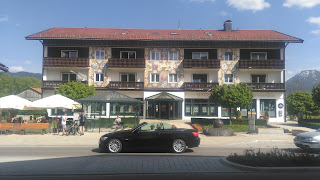MY round-seven game in the International Seniors Cup at Bad Wiessee, a resort on the Tegernsee, a lake in south Bavaraia, finished before noon, so I decided today would be a good day to ascend the Fockenstein.
It is a 1,564metre mountain that can be hiked almost all the way on a well-kept forest trail, signposted with the usual southern German emphasis on usefulness, ie the distances are given in hours and minutes rather than kilometres.
The walk starts from Bad Wiessee, which, at its central point, is 740 metres above sea level. For comparison, Ben Nevis, the highest point in the British Isles, is at 1,345 metres.
It is quite a steep ascent at first, which is part of the reason why on Monday, when I started from the same point, I turned off onto Bad Wiessee's Panorama Wanderweg.
I was made of sterner stuff today, but was quite surprised when patches of snow appeared well within the first hour.
 |
| Snow on the ground in the lower Alps in April shouldn't be a shocker, but there were times later when I had to get my walking pole out and I regretted wearing ordinary trainers |
Nearly all the way, the trail is wide enough for a vehicle to pass, which means it was easy to admire the scenery while not having to watch one's step.
Admittedly, the scenery consisted mostly of tall trees on either side, and all the time I was walking along a fast-flowing mountain stream full of large boulders and fallen tree trunks - evidence of past storms and dramatic weather.
 |
| A wooden sculpture, but what is it ... a boar, maybe, or a dog? |
I could not make out what was represented in the above picture, but you may be able to read on the plinth that it was carved on 15.9.15.
"Wow! That's more than 100 years old," I thought, which is why I got my mobile out and took the snap.
It was only when I passed it again on the way down that I realised the second 15 more than likely referred to 2015, not 1915. I put this down to just having started reading a book on the 1565 siege of Malta - my mind is set in (relatively) ancient times.
Eventually I emerged from the trees, at Aueralm, which, at 1,299 metres, can look down, if it felt the effort worthwhile, on England's tallest mountain, Scafell Pike (978 metres).
 |
| The view on emerging from the trees at Aueralm |
Although I was by no means above the tree level, it was now open going and time to don my trusty Chinese sunhat (actually, from Millets in Hastings, but made in China) and my cerise (not pink) neckerchief from Corsica.
 |
| Giant, or at least threatening, spiders are apparently a hazard at Aueralm |
Frankly, if I had not planned to blog about this walk, I probably would have given up long before I reached the summit.
It was not the Aueralm arachnids that worried me, but rather that I had not done a proper walk for several months, and I had been especially foolish on this occasion by wearing ordinary trainers and white sports socks rather than walking boots, or at least walking shoes, and decent hikers' socks.
Added to that, I set off with a lunch consisting of a Bavarian cheese platter, two bread rolls, some sort of salad in mayonnaise and a large glass-jar of yogurt.
I ate everything except the yogurt fairly on in the walk, but kept the yogurt, glass container and all, for when I reached the summit. The flavour was stracciatella - my favourite, at the moment - but I should have made do with a couple of other flavours in smaller, but above all plastic, pots.
 |
| The snow above Aueralm had a striking pattern |
One problem with using a mobile phone to take pix is that, even more than with a normal camera, it flattens perspective.
You will just have to take my word for it that the final push to the summit of Fockenstein was quite a challenge - even more so coming down, which I did largely on my bottom.
 |
| This was almost vertical ... honest! |
The view from the top was spectacular, even though vertigo meant I could not fully enjoy looking back to where I had begun at Bad Wiessee and the Tegernsee lake.
 |
| A cross at the top of Fockenstein, with the Tegernsee just visible in the background |
Oh, and just in case anyone thinks I have downloaded these images from the internet, here I am at the summit, trying to show I have no fear of heights.
 |
| At the top of the Fockenstien (hat by Millets, shirt by Primark) |
PS My chess game, which I won unexpectedly quickly in 26 moves, was against a 2075 - just my luck that the tournament does not count for international ratings (as the good book says, "All is vanity. What does man gain by all the toil at which he toils?")

































